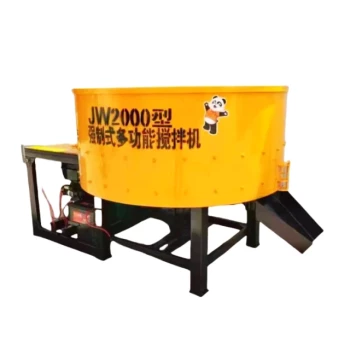Mortar mixers and cement mixers differ primarily in their drum design and mixing mechanisms to accommodate their respective materials. Mortar mixers feature a stationary drum with rotating paddles optimized for viscous mortar, while cement mixers use a rotating barrel-shaped drum to mix fluid concrete with aggregates through tumbling action. The shape differences reflect their distinct applications—mortar mixers prioritize precision for fine mixtures, whereas cement mixers emphasize volume and aggregate handling.
Key Points Explained:
-
Drum Design & Mobility
- Mortar Mixers: Stationary drum with internal rotating paddles. The open-top design allows direct bag breaking and manual addition of materials.
- Cement Mixers: Barrel-shaped rotating drum (often tilted) that mixes materials through gravity-driven tumbling. The drum rotates around a horizontal or inclined axis, ideal for fluid concrete with coarse aggregates.
-
Mixing Mechanism
- Mortar Mixers: Paddles aggressively blend thick, adhesive mortar to ensure homogeneity without air pockets.
- Cement Mixers: The drum’s rotation relies on the tumbling of materials, which is efficient for combining cement, water, and aggregates like gravel.
-
Capacity & Application
- Mortar Mixers: Smaller capacity (typically 1–9 cubic feet) for precise masonry work (e.g., bricklaying).
- Cement Mixers: Larger (3–12 cubic feet) to handle high-volume projects like foundations. Their machine for cement design prioritizes mobility and continuous mixing.
-
Material Suitability
- Mortar Mixers: Optimized for fine sand, lime, and cement blends (no large aggregates).
- Cement Mixers: Engineered for coarse aggregates (up to 3/4 inch) and fluid concrete mixes.
-
User Workflow
- Mortar mixers often include features like foldable legs for job-site portability, while cement mixers may have towable trailers for transport.
These shape and functional differences ensure each mixer type performs optimally for its intended material, balancing efficiency with material-specific handling needs.
Summary Table:
| Feature | Mortar Mixers | Cement Mixers |
|---|---|---|
| Drum Design | Stationary with rotating paddles | Rotating barrel-shaped drum |
| Mixing Mechanism | Paddle-driven for viscous mortar | Tumbling action for fluid concrete |
| Capacity | 1–9 cubic feet (precise masonry work) | 3–12 cubic feet (high-volume projects) |
| Material Suitability | Fine sand, lime, cement blends | Coarse aggregates (up to 3/4 inch) |
| Mobility | Foldable legs for portability | Towable trailers for transport |
Upgrade your construction efficiency with the right mixer for your project. Contact GARLWAY today to explore our durable mortar and cement mixers, designed for precision and high-volume performance. Whether you're a contractor handling masonry or large-scale concrete work, we provide reliable machinery tailored to your needs.
Related Products
- JDC350 Small Cement Concrete Mortar Mixer
- Portable Concrete Mixer Machine Equipment for Mixing Concrete
- Commercial Construction Mixer Machine for Soil Cement Mixing Concrete
- HZS75 Concrete Batching Plant Cement Mixer Price Concrete Mixer Bunnings Mixing Plant
- HZS180 Ready Mix Concrete Plant for Foundations with Sand and Cement
People Also Ask
- What are the 4 classifications of concrete mix? Essential Guide for Construction Pros
- How much does a portable concrete mixer hold? Find the Right Capacity for Your Project
- How much weight can a cement mixer hold? Understanding Capacity for Optimal Use
- Do you put water or cement in a cement mixer first? The Right Order for Perfect Concrete
- Can you mix self leveling concrete in a cement mixer? Why Specialized Equipment Matters



















